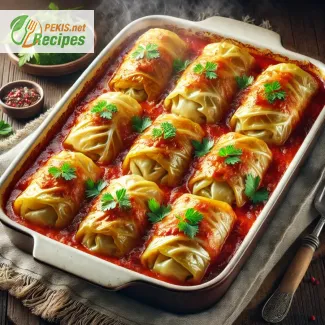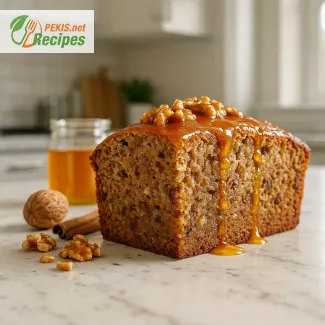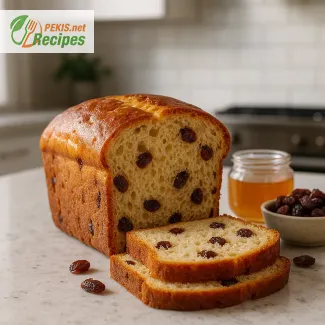
Imagine a dish that embodies comfort, flavor, and culinary heritage all in one bite—welcome to the world of Cabbage Rolls with Meat. These tender rolls, packed with a savory meat filling and wrapped in soft cabbage leaves, are more than just a meal; they’re an experience that combines the richness of meat, earthiness of cabbage, and aromatic spices for a harmonious blend that feels like home. From traditional family recipes to modern twists, cabbage rolls have evolved into a versatile dish beloved across Europe and beyond. Stuffed and baked to perfection, each roll is a symphony of flavors and textures, where the juicy filling meets a delicate yet flavorful cabbage casing, offering a meal that’s as satisfying as it is comforting.
The core of this dish lies in its hearty meat filling, typically crafted with a mixture of ground beef, pork, or a blend that brings out the best of both worlds. To this, finely chopped onions, garlic, and a sprinkle of herbs and spices are added, creating a robust flavor profile that complements the mildness of the cabbage. The filling is seasoned with precision, ensuring each roll has the perfect balance of richness and aromatic warmth. Some variations also include rice for an extra layer of texture and to absorb all the flavors while baking, transforming each roll into a complete, satisfying bite.
A big part of what makes cabbage rolls so appealing is the unique preparation process. First, fresh cabbage leaves are carefully separated and blanched until they’re soft and pliable, making them easy to wrap around the filling. This step is crucial, as it softens the leaves while retaining their subtle, sweet flavor, which enhances the dish’s overall taste. Each leaf is then filled with a generous portion of the meat mixture, rolled up like a little parcel of flavor, and tucked tightly to hold the filling inside. The result is a compact roll that’s ready to absorb the flavors of the cooking sauce.
The final step involves baking the rolls, typically in a rich tomato sauce that envelops each roll and adds an additional layer of depth to the dish. The sauce is a key element here, as it infuses the cabbage and meat with a slight tang, balancing the richness of the meat and the mild sweetness of the cabbage. This process also allows the rolls to cook slowly, letting the flavors meld together while keeping the meat filling juicy and tender. The aroma that fills the kitchen as the rolls bake is nothing short of mouthwatering, drawing everyone to the table.
Once baked, cabbage rolls emerge from the oven beautifully tender and flavor-packed, with the sauce bubbling around them, adding a velvety texture to each bite. Served hot, often with a side of mashed potatoes, crusty bread, or even sour cream for a creamy contrast, cabbage rolls are a meal that brings warmth and comfort to any table. They’re not only a favorite among those who love traditional flavors but also among those seeking a wholesome, home-cooked meal that’s as nourishing as it is satisfying.
For the health-conscious, cabbage rolls offer a great balance of protein, fiber, and essential nutrients. Cabbage is low in calories yet high in vitamins C and K, while the meat filling provides a good dose of protein and essential minerals. This makes cabbage rolls a meal that’s not only delicious but also supportive of a balanced diet.
Whether enjoyed as part of a family gathering, shared with friends, or savored alone, Cabbage Rolls with Meat are a testament to the timeless appeal of simple ingredients brought together with care. Each roll is a little bundle of warmth, love, and tradition, offering a taste that’s both comforting and deeply satisfying. So, if you’re looking for a dish that’s rich in flavor, steeped in tradition, and filled with heart, cabbage rolls are the answer—simple, delicious, and unforgettable.
- Prepare the Cabbage:
- Carefully peel off 8 large cabbage leaves, wash them, and blanch in boiling water for 3-4 minutes until softened. Drain and set aside to cool.
- Prepare the Filling:
- In a bowl, combine the ground beef, ground pork, cooked rice, finely chopped onion, minced garlic, egg, tomato paste, salt, black pepper, and paprika. Mix until well combined.
- Assemble the Rolls:
- Place a blanched cabbage leaf on a flat surface. Spoon about 2 tablespoons of the meat mixture onto the center of the leaf. Fold the sides over the filling, then roll up tightly. Repeat with the remaining leaves and filling.
- Prepare the Sauce:
- In a large skillet or baking dish, heat the olive oil over medium heat. Pour in the tomato sauce and vegetable broth, stirring to combine. Bring to a simmer.
- Bake the Rolls:
- Place the cabbage rolls in the sauce, seam-side down, ensuring they are covered with sauce. Cover with foil and bake at 180°C (350°F) for 1 hour.
- Serve:
- Carefully remove the cabbage rolls from the oven and let them rest for a few minutes before serving. Serve hot with a drizzle of sauce from the baking dish.
Enhancing a recipe like Cabbage Rolls with Meat involves a range of techniques, ingredient substitutions, and adjustments to tailor it to different dietary needs, flavor preferences, or cooking styles. From creating a lighter version to amplifying the flavors or adapting it to suit specific dietary restrictions, here are professional insights and expert tips for optimizing this classic recipe.
1. Enhancing Flavor Profiles
The base recipe calls for a simple seasoning of salt, pepper, and paprika, but additional spices and herbs can elevate the flavor to new heights. Here are some ways to infuse extra depth:
- Garlic Powder and Onion Powder: While fresh garlic and onions are used, adding a pinch of garlic powder or onion powder to the meat mixture intensifies these flavors.
- Smoked Paprika: Substitute regular paprika with smoked paprika to add a hint of smokiness, which pairs well with the sweetness of cabbage.
- Cumin or Coriander: A small amount (about 1/4 tsp) of ground cumin or coriander adds an earthy warmth that enhances the meat’s natural flavor.
- Fresh Herbs: Adding chopped parsley, thyme, or dill to the meat mixture or garnishing the finished rolls with fresh herbs can add a burst of freshness and visual appeal.
- Bay Leaves: Place a few bay leaves in the baking dish while cooking to introduce subtle aromatic notes that infuse both the rolls and the sauce.
2. Healthier Adjustments
For those looking to reduce the fat and calorie content without sacrificing flavor, here are some adjustments that help make the dish lighter:
- Lean Meats: Substitute a portion of the ground pork and beef with leaner meats such as ground turkey or chicken. This reduces saturated fat while still providing a good protein content.
- Vegetable-Based Fillings: Consider adding finely grated carrots, zucchini, or even mushrooms to the filling mixture. These vegetables add bulk, fiber, and moisture, allowing you to use less meat while keeping the filling juicy.
- Reduced Sodium: Opt for a low-sodium vegetable broth and decrease the added salt in both the filling and sauce to create a heart-healthy version.
3. Dairy-Free and Egg-Free Modifications
While the base recipe does not contain dairy, there is an egg included in the meat mixture. Here’s how to make it egg-free or adjust the texture for dietary needs:
- Egg Substitute: Replace the egg with a flaxseed mixture (1 tbsp ground flaxseed mixed with 3 tbsp water, let sit for 5 minutes to thicken). This binds the filling while adding a boost of fiber and omega-3 fatty acids.
- Gluten-Free Option: For those with gluten sensitivity, ensure the vegetable broth used is certified gluten-free. Rice serves as the grain in the filling, so it’s naturally gluten-free.
4. Creative Variations
Adapt the classic recipe to suit different tastes or to incorporate seasonal ingredients. Here are a few variations that give a creative spin on traditional cabbage rolls:
- Mediterranean Style: Replace the tomato sauce with a combination of diced tomatoes, fresh basil, and oregano. Add some chopped olives and a sprinkle of feta cheese over the rolls before serving to bring a Mediterranean flair.
- Spicy Twist: Add chopped chili or a pinch of chili powder to the filling to create a mild heat. This works especially well with smoked paprika for a spiced, smoky profile.
- Asian-Inspired Cabbage Rolls: Substitute the tomato sauce with a sauce made from soy sauce, ginger, garlic, and a bit of sesame oil. Use Napa cabbage leaves instead of regular cabbage for a slightly softer texture. Optionally, add finely chopped water chestnuts for a bit of crunch in the filling.
5. Vegetarian and Vegan Adaptations
Turning cabbage rolls into a vegetarian or vegan-friendly dish is quite simple with a few smart substitutions:
- Plant-Based Proteins: Replace the meat with a mixture of lentils, chickpeas, or tofu. Finely crumbled tofu or textured vegetable protein (TVP) mimics the texture of ground meat when cooked.
- Extra Vegetables: Enhance the filling by adding grated carrots, finely chopped mushrooms, and bell peppers. These vegetables add a nice depth of flavor and texture.
- Nutritional Yeast: For added umami, sprinkle nutritional yeast into the filling mixture. This ingredient provides a cheesy, savory flavor that enhances the vegetarian filling.
- Vegan Sauce: Use a vegetable-based broth and ensure all other ingredients are free of animal products.
6. Cooking Techniques and Baking Tips
Baking cabbage rolls can sometimes result in uneven cooking if not properly managed. Here are some cooking tips to ensure even, perfectly tender cabbage rolls:
- Pre-Blanch the Cabbage: While the recipe suggests blanching the cabbage leaves for pliability, it’s essential to blanch them for the right amount of time. Aim for 3-4 minutes to soften without overcooking, which can cause tearing during rolling.
- Use a Covered Baking Dish: Cover the baking dish with aluminum foil to trap steam, which helps cook the rolls evenly. This technique prevents drying out and keeps the cabbage leaves tender and the filling juicy.
- Layering the Sauce: Pour a layer of tomato sauce at the bottom of the baking dish before adding the cabbage rolls. This keeps the bottom of the rolls moist and prevents them from sticking to the dish. Reserve a portion of the sauce to spoon over the rolls as they cook.
7. Serving Suggestions and Presentation
Enhance the presentation and serving style to create a visually appealing dish that can be served for various occasions, from family dinners to festive gatherings:
- Serving with Sides: Serve cabbage rolls alongside mashed potatoes, crusty bread, or a refreshing cucumber salad to balance the richness of the rolls.
- Garnish: Top with a sprinkle of fresh parsley, a dollop of sour cream, or thinly sliced green onions for added color and flavor. For a Mediterranean version, a bit of crumbled feta or a sprinkle of oregano adds an authentic touch.
- Individual Portions: For a refined presentation, serve each roll individually plated with a spoonful of sauce drizzled around it. Garnish with microgreens or edible flowers for a restaurant-quality finish.
8. Nutritional and Health Benefits
The ingredients in cabbage rolls offer several health benefits, and small adjustments can make them even more nutritious:
- Cabbage: Rich in Vitamin C, which is essential for immune support and skin health. It also contains fiber and antioxidants, which promote digestion and combat inflammation.
- Lean Meat: Provides protein necessary for muscle repair and growth. Ground chicken or turkey can reduce saturated fat if desired.
- Tomato Sauce: Contains lycopene, an antioxidant known for its heart health benefits and potential cancer-fighting properties.
- Onions and Garlic: Both contain antioxidants and compounds that support cardiovascular health and have natural anti-inflammatory properties.
9. Storage and Meal Prep Tips
Cabbage rolls are ideal for meal prep or make-ahead options. Here’s how to store and reheat for best results:
- Refrigeration: Store cooked cabbage rolls in an airtight container in the refrigerator for up to 3-4 days. Reheat in the oven or microwave with a bit of extra sauce to keep them moist.
- Freezing: To freeze, place rolls in a single layer in a freezer-safe dish, cover with sauce, and freeze. Defrost in the fridge overnight before reheating in the oven at 180°C (350°F) for 30-40 minutes until heated through.
10. Making It Kid-Friendly
If making this dish for children, consider some adjustments to create a more kid-friendly version:
- Mild Seasoning: Tone down the spices to keep it simple and familiar for young palates. Use less black pepper and omit the chili if included in the variation.
- Mini Rolls: Make smaller rolls with half the filling size for easier, hand-held portions.
- Cheese Addition: A sprinkle of cheese on top before baking or a mild cheese in the filling can add appeal for children and provide extra calcium.
This comprehensive guide helps you tailor Cabbage Rolls with Meat to various tastes, dietary requirements, and occasions. With these tips, you can enjoy a dish that’s not only delicious but also customizable, versatile, and health-conscious, offering the best of tradition with modern adjustments to fit your lifestyle.
- Egg: Contains egg, which can be replaced with a flaxseed egg (1 tbsp flaxseed + 3 tbsp water).
- Gluten: Naturally gluten-free if using gluten-free vegetable broth and rice.
Ingredient Substitution Tips
- For egg allergy: Substitute with a flaxseed egg as mentioned.
- For low-sodium: Use a reduced-sodium vegetable broth and reduce added salt.
- For dairy-free version: Recipe is already dairy-free.
- Vitamin C: Cabbage is rich in Vitamin C, supporting immune health and skin.
- Vitamin K: Essential for bone health and blood clotting.
- Iron: Ground meat contributes iron, vital for oxygen transport in the body.
- Potassium: Supports cardiovascular health and helps maintain fluid balance.
- Beta-carotene: Found in cabbage, beneficial for skin health and vision.
- Lycopene: Present in tomato sauce, supports heart health.
- Flavonoids: In onions and garlic, contributing to anti-inflammatory properties.





